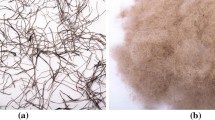Abstract
This study investigated various types of fibre length, fibre diameter, fibre type and fibre content on the degree of spalling of concrete in fire. Four types of fibres, namely, polypropylene, polyvinyl alcohol, cellulose and nylon with various lengths and diameters were studied. Fibre contents ranged from 0.05 to 0.15% by volume of concrete. Fire tests were conducted according to the ISO 834 standard heating curve. Results showed that when comparing all the fibres under the same fibre content levels (% volume of concrete), the nylon fibre was the most effective in protecting concrete from spalling. This is because the diameter of the nylon fibres were significantly less than the other fibres, hence there were significantly more number of nylon fibres present for the same fibre content (% volume) in concrete. Analysis revealed, regardless of the amount of fibre, the type of fibre, diameter of and length of fibre, there is a strong relationship between the total number of fibres present per unit volume, length of fibres and the degree of spalling observed. Based on this relationship, the authors established a critical minimum for total number of fibres per unit volume for spalling protection in fire.












Similar content being viewed by others
References
Copier WJ (1983) The spalling of normal weight and lightweight concrete exposed to fire. ACI Mater J 80:219–236
Sanjayan G, Stocks L (1991) Spalling of High-Strength Concrete in Fire. American Concrete Institute 1991 Spring Convention, Boston, pp 1–18
Hertz KD (1992) Danish investigations on silica fume concretes at elevated temperatures. ACI Mater J 89:345–347
Britenbucker R (1996) High strength concrete C105 with increased fire resistance due to polypropylene fibres. In: Proceedings of 4th international symposium on utilization of high strength/high performance concrete, Paris, France, pp 571–578
Bayasi Z, Dhaheri MA (2002) Effect of exposure to elevated temperature on polypropylene fibre-reinforced concrete. ACI Mater J 99:22–26
Han CG, Hwang YS, Yang SH, Gowripalan N (2005) Performance of spalling resistance of high performance concrete with polypropylene fibre contents and lateral confinement. Cem Concr Res 35:1747–1753
Kalifa P, Chene G, Galle C (2001) High-temperature behaviour of HPC with polypropylene fibres from spalling to microstructure. Cem Concr Res 31:1487–1499
Phan LT (2007) Spalling and mechanical properties of high strength concrete at high temperature. In: Proceedings concrete under severe conditions, France, pp 1595–1608
Bilodeau A, Kodur VKR, Hoff GC (2004) Optimization of the type and amount of polypropylene fibres for preventing the spalling of lightweight concrete subjected to hydrocarbon fire. Cem Concr Res 26:163–174
Suhaendi SL, Horiguchi T (2006) Effect of short fibres on residual permeability and mechanical properties of hybrid fibre reinforced high strength concrete after heat exposition. Cem Concr Res 36:1672–1678
Garboczi EJ, Snyder KA, Douglas JF, Thorpe MF (1995) Geometrical percolation threshold of overlapping ellipsoids. Phys Rev E 52:819–828
Dale PB (2000) Fibres, percolation, and spalling of high-performance concrete. ACI Mater J 97:351–359
Han CG, Yang SH, Han MC, Pei CC (2008) Spalling prevention of high strength concrete with 60–100 MPa of the compressive strength corresponding to addition of polypropylene fibre. Arch Inst Korea 24:91–98
Han CG, Han MC, Heo YS (2009) Improvement of residual compressive strength and spalling resistance of high-strength RC columns subjected to fire. Constr Build Mater 23:107–116
Acknowledgments
The work presented in this paper was funded by Centre for Concrete Corea (05-CCT-D11), supported by Korea Institute of Construction and Transportation Technology Evaluation and Planning (KICTTEP) under Ministry of Construction and Transportation (MOCT) and also funded by Monash Graduate Scholarship (MGS) from Monash University.
Author information
Authors and Affiliations
Corresponding author
Rights and permissions
About this article
Cite this article
Heo, YS., Sanjayan, J.G., Han, CG. et al. Critical parameters of nylon and other fibres for spalling protection of high strength concrete in fire. Mater Struct 44, 599–610 (2011). https://doi.org/10.1617/s11527-010-9651-3
Received:
Accepted:
Published:
Issue Date:
DOI: https://doi.org/10.1617/s11527-010-9651-3




